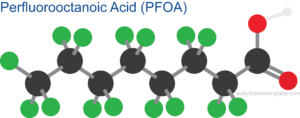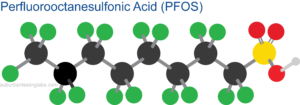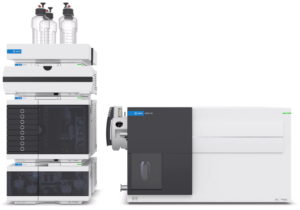 Environmental Testing for PFAS (Per/Polyfluoroalkyl Substances)
Environmental Testing for PFAS (Per/Polyfluoroalkyl Substances)
Accredited laboratories performing PFAS analysis in Pennsylvania, New Jersey, Maryland, and Delaware are extremely rare. We are proud to announce that Suburban Testing Labs is your trusted resource for your PFAS testing needs in drinking water and wastewater at our laboratory in Reading, PA. Your analysis will be handled right at our headquarters without the need to ship samples to an out-of-state facility. You can have peace of mind knowing your samples will be handled locally by trusted professionals.
- Drinking Water PFAS Testing
- Non-Potable Water, Wastewater, Groundwater PFAS Testing
- EPA’s UCMR5 Drinking Water Testing
Studies have shown that PFOA and PFOS, two members of the PFAS family of chemicals, are harmful to human, animal, and aquatic life. PFAS chemicals have been used in consumer products, industrial processes, and manufacturing since the 1940s. They have been shown to have harmful reproductive, developmental, and immunological side effects. As a result, environmental testing requirements for PFAS are emerging in the US in both state and federal jurisdictions to help protect human health and preserve the environment.
History of PFAS1 – The “Forever Chemical”
PFOA was first mass-manufactured by 3M in 1947, and DuPont started using it to make Teflon in 1951. PFOS was accidentally spilled on the shoe of a chemist at 3M in 1953, which led to the discovery that the coating repels oil and water and the creation of “Scotchgard.”
In the 1960’s the US Navy and 3M developed a firefighting foam containing PFOS and PFOA. And in the 1970s various airports, military sites, and firefighters began using the product. Around this same time, it was discovered that PFAS was toxic to animals and humans.
 In the 1980’s the US Navy discovered these contaminants are harmful to aquatic life, and 3M proved employees had PFAS detections in their blood. DuPont discovered PFOA could pass from mother to unborn baby.
In the 1980’s the US Navy discovered these contaminants are harmful to aquatic life, and 3M proved employees had PFAS detections in their blood. DuPont discovered PFOA could pass from mother to unborn baby.
 In 1999 the battle against the use and manufacturing of these chemicals began. The USEPA and 3M found PFOS contamination in blood banks. A farmer in West Virginia sued DuPont after his cattle mysteriously died near a DuPont plant where tons of PFOS were dumped into a local landfill. This disposal polluted the Ohio River and the drinking water supply for more than 80,000 people. The spotlight was on the manufacturers to do better to protect public health.
In 1999 the battle against the use and manufacturing of these chemicals began. The USEPA and 3M found PFOS contamination in blood banks. A farmer in West Virginia sued DuPont after his cattle mysteriously died near a DuPont plant where tons of PFOS were dumped into a local landfill. This disposal polluted the Ohio River and the drinking water supply for more than 80,000 people. The spotlight was on the manufacturers to do better to protect public health.
In 2000, 3M stopped production of PFOA and PFOS but started creating new “short-chain” PFAS formulations. The industry believed these PFAS compounds to be safer. “Long-chain” and “short-chain” refer to the number of fluorine atoms in the compounds.4
EPA concluded PFOA was a likely human carcinogen in 2005, and the next year EPA encouraged all manufactures to stop making long-chain PFAS. DuPont agreed but started making short-chain varieties.
Since 2009 the EPA has been working to implement limits of PFAS in drinking water. Forms of PFAS are estimated to be present in the blood of 98% of Americans, detected at many military sites, and present in hundreds of drinking water supplies in excess of EPA’s health advisory.
PFAS is referred to as a “forever chemical” because they do not break down in the environment, and bioaccumulate in humans. Scientists estimate it could take hundreds, or even thousands, of years to break down in the environment naturally.5
PFAS Today
Americans are exposed to PFAS from a variety of sources every day, including drinking contaminated water, eating fish from contaminated waterways, inhaling dust or soil, eating food packaged with PFAS materials, and exposure to consumer products with PFAS like non-stick cookware, stain-resistant carpets, and water repellent clothing.2 FDA studies showed that short-chain PFAS can accumulate in the liver, fat, and plasma of rats, and persist for half of their lifespan.4
PFAS contamination has been linked to numerous health concerns in humans including kidney cancer, testicular cancer, thyroid disease, liver damage, pregnancy-induced preeclampsia, and immune disfunctions.5
Recently, there has been significant pressure on lawmakers to prioritize and fast-track PFAS regulations to understand and reduce this harmful exposure.
Testing for PFAS in Drinking Water

There are currently two approved methods to quantify PFAS in drinking water: EPA 533 and EPA 537.1. Suburban Testing Labs will be accredited to perform both methods. Both methods require a solid phase extraction (SPE) on the sample, followed by analysis using Liquid Chromatography with tandem Mass Spectrometry (LC-MS-MS).
While sample collection protocol is complex and still under development by our field sciences team, the sample container is simple. For drinking water a 250 mL polypropylene (plastic) preserved with trizma as a pH buffer. For non-potable water use a 500 mL High Density Polyethylene (HDPE), plastic container. You should get these containers from our laboratory to ensure they are free of PFAS compounds.
![]() We have obtained accreditation for performing analysis of 18 PFAS compounds in drinking water by EPA 537.1 for samples in Pennsylvania, Maryland, and Delaware. We are the only privately-owned, independent, single site laboratory in Pennsylvania with this testing capability.
We have obtained accreditation for performing analysis of 18 PFAS compounds in drinking water by EPA 537.1 for samples in Pennsylvania, Maryland, and Delaware. We are the only privately-owned, independent, single site laboratory in Pennsylvania with this testing capability.
Scroll to the section below for information specific to the UCMR5 Rule.
| Analyte Name | Abbreviation | MDL µg/L | MRL µg/L |
| Hexafluoropropylene Oxide Dimer Acid | HFPO-DA | 0.002 | 0.002 |
| N-ethyl Perfluorooctanesulfonamidoacetic Acid | NEtFOSAA | 0.002 | 0.002 |
| N-methyl Perfluorooctanesulfonamidoacetic Acid | NMeFOSAA | 0.002 | 0.002 |
| Perfluorobutanesulfonic Acid | PFBS | 0.002 | 0.002 |
| Perfluorodecanoic Acid | PFDA | 0.002 | 0.002 |
| Perfluorododecanoic Acid | PFDoA | 0.002 | 0.002 |
| Perfluoroheptanoic Acid | PFHpA | 0.002 | 0.002 |
| Perfluorohexanesulfonic Acid | PFHxS | 0.002 | 0.002 |
| Perfluorohexanoic Acid | PFHxA | 0.002 | 0.002 |
| Perfluorononanoic Acid | PFNA | 0.002 | 0.002 |
| Perfluorooctanesulfonic Acid | PFOS | 0.002 | 0.002 |
| Perfluorooctanoic Acid | PFOA | 0.002 | 0.002 |
| Perfluorotetradecanoic Acid | PFTA | 0.002 | 0.002 |
| Perfluorotridecanoic Acid | PFTrDA | 0.002 | 0.002 |
| Perfluoroundecanoic Acid | PFUnA | 0.002 | 0.002 |
| 11-chloroeicosafluoro-3-oxaundecane-1-sulfonic… | 11Cl-PF3OUdS | 0.002 | 0.002 |
| 9-Chlorohexadecafluoro-3-oxanonane-1-sulfonic acid | 9Cl-PF3ONS | 0.002 | 0.002 |
| 4,8-Dioxa-3H-Perfluorononanoic Acid | ADONA | 0.002 | 0.002 |
Non-Potable Water, Wastewater, Groundwater PFAS Testing
EPA Method 1633 for the determination of the per- and polufluoroalkyl substances (PFAS) quantifies PFAS analytes listed in the table below. The routine Reporting Limit (MRL) and the Method Detection Limit (MDL) are currently the same. Areas appearing blank in the chart below are not yet defined or developed.
The sample container is a 250 mL polypropylene (plastic) preserved with trizma as a pH buffer. Field Reagent Blanks should be collected when testing for compliance purposes.
| Analyte Name | Abbreviation | MDL (µg/L) | MRL (µg/L) |
| Perfluoro-4-methoxybutanoic Acid | PFBA | 0.008 | 0.008 |
| Perfluoropentanoic Acid | PFPeA | 0.004 | 0.004 |
| Perfluorohexanoic Acid | PFHxA | 0.002 | 0.002 |
| Perfluoroheptanoic Acid | PFHpA | 0.002 | 0.002 |
| Perfluorooctanoic Acid | PFOA | 0.002 | 0.002 |
| Perfluorononanoic Acid | PFNA | 0.002 | 0.002 |
| Perfluorodecanoic Acid | PFDA | 0.002 | 0.002 |
| Perfluoroundecanoic Acid | PFUnA | 0.002 | 0.002 |
| Perfluorododecanoic Acid | PFDoA | 0.002 | 0.002 |
| Perfluorotridecanoic Acid | PFTrDA | 0.002 | 0.002 |
| Perfluorotetradecanoic Acid | PFTA | 0.002 | 0.002 |
| Perfluorobutanesulfonic Acid | PFBS | 0.002 | 0.002 |
| Perfluoropentanesulfonic Acid | PFPeS | 0.002 | 0.002 |
| Perfluorohexanesulfonic Acid | PFHxS | 0.002 | 0.002 |
| Perfluoroheptanesulfonic Acid | PFHpS | 0.002 | 0.002 |
| Perfluorooctanesulfonic Acid | PFOS | 0.002 | 0.002 |
| Perfluorononanesulfonic Acid | PFNS | 0.002 | 0.002 |
| Perfluorodecanesulfonic Acid | PFDS | 0.002 | 0.002 |
| Perfluorododecanesulfonic Acid | PFDoS | 0.002 | 0.002 |
| 1H,1H,2H,2H-Perfluorohexane Sulfonic Acid | 4:2FTS | 0.008 | 0.008 |
| 1H,1H,2H,2H-Perfluorooctane Sulfonic Acid | 6:2FTS | 0.008 | 0.008 |
| 1H,1H,2H,2H-Perflurodecane Sulfonic Acid | 8:2FTS | 0.008 | 0.008 |
| Perfluorooctanesulfonamide | PFOSA | 0.002 | 0.002 |
| N-methyl Perfluorooctanesulfonamide | NMeFOSA | 0.002 | 0.002 |
| N-ethyl Perfluorooctanesulfonamide | NEtFOSA | 0.002 | 0.002 |
| N-methyl Perfluorooctanesulfonamidoacetic Acid | NMeFOSAA | 0.002 | 0.002 |
| N-ethyl Perfluorooctanesulfonamidoacetic Acid | NEtFOSAA | 0.002 | 0.002 |
| N-methyl perfluorooctanesulfonamidoethanol | NMeFOSE | 0.02 | 0.02 |
| N-ethyl Perfluorooctanesulfonamidoethanol | NEtFOSE | 0.02 | 0.02 |
| Hexafluoropropylene Oxide Dimer Acid | HFPO-DA | 0.008 | 0.008 |
| 4,8-Dioxa-3H-Perfluorononanoic Acid | ADONA | 0.008 | 0.008 |
| 9-Chlorohexadecafluoro-3-oxanonane-1-sulfonic acid | 9Cl-PF3ONS | 0.008 | 0.008 |
| 11-chloroeicosafluoro-3-oxaundecane-1-sulfonic… | 11Cl-PF3OUdS | 0.008 | 0.008 |
| 3-Perfluoropropyl Propanoic Acid | 3:3FTCA | 0.01 | 0.01 |
| 2H,2H,3H,3H-Perfluorooctanoic Acid | 5:3FTCA | 0.05 | 0.05 |
| 3-Perfluoroheptyl Propanoic Acid | 7:3FTCA | 0.05 | 0.05 |
| Perfluoro(2-ethoxyethane)sulfonic Acid | PFEESA | 0.004 | 0.004 |
| Perfluoro-3-methoxypropanoic Acid | PFMPA | 0.004 | 0.004 |
| Perfluoro-4-methoxybutanoic Acid | PFMBA | 0.004 | 0.004 |
| Nonafluoro-3,6-Dioxaheptanoic Acid | NFDHA | 0.004 | 0.004 |
UCMR 5
While many states have, or are considering adopting, environmental PFAS monitoring requirements, the USEPA is taking steps at the federal level by including twenty-nine Per- and Polyfluoroalkyl Substances in the Fifth Unregulated Contaminant Monitoring (UCMR5) to evaluate if these compounds should be included in the Safe Drinking Water Act (SDWA). This monitoring will be crucial to improving our understanding of the frequency and levels of these contaminants in our nation’s drinking water systems.
Sample collection and analysis will be required between 2023 and 2025 at all entry points for community systems that serve a population greater than 3,300. 800 randomly selected systems under 3,300 will also be required to monitor. Systems will also be required to monitor for Lithium. Visit USEPA’s website for more information.
EPA 533 UCMR5 Contaminant List3
| Contaminant | CAS Number | MRL |
| 11-chloroeicosafluoro-3-oxaundecane-1-sulfonic acid (11Cl-PF3OUdS) | 763051-92-9 | 0.005 µg/L |
| 9-chlorohexadecafluoro-3-oxanonane-1-sulfonic acid (9Cl-PF3ONS) | 756426-58-1 | 0.002 µg/L |
| 4,8-dioxa-3H-perfluorononanoic acid (ADONA)2 | 919005-14-4 | 0.003 µg/L |
| hexafluoropropylene oxide dimer acid (HFPO‑DA) | 13252-13-6 | 0.005 µg/L |
| nonafluoro-3,6-dioxaheptanoic acid (NFDHA) | 151772-58-6 | 0.02 µg/L |
| perfluorobutanoic acid (PFBA) | 375-22-4 | 0.005 µg/L |
| perfluorobutanesulfonic acid (PFBS) | 375-73-5 | 0.003 µg/L |
| 1H,1H, 2H, 2H-perfluorodecane sulfonic acid (8:2FTS) | 39108-34-4 | 0.005 µg/L |
| perfluorodecanoic acid (PFDA) | 335-76-2 | 0.003 µg/L |
| perfluorododecanoic acid (PFDoA) | 307-55-1 | 0.003 µg/L |
| perfluoro(2-ethoxyethane)sulfonic acid (PFEESA) | 113507-82-7 | 0.003 µg/L |
| perfluoroheptanesulfonic acid (PFHpS) | 375-92-8 | 0.003 µg/L |
| perfluoroheptanoic acid (PFHpA) | 375-85-9 | 0.003 µg/L |
| 1H,1H, 2H, 2H-perfluorohexane sulfonic acid (4:2FTS) | 757124-72-4 | 0.003 µg/L |
| perfluorohexanesulfonic acid (PFHxS) | 355-46-4 | 0.003 µg/L |
| perfluorohexanoic acid (PFHxA) | 307-24-4 | 0.003 µg/L |
| perfluoro-3-methoxypropanoic acid (PFMPA) | 377-73-1 | 0.004 µg/L |
| perfluoro-4-methoxybutanoic acid (PFMBA) | 863090-89-5 | 0.003 µg/L |
| perfluorononanoic acid (PFNA) | 375-95-1 | 0.004 µg/L |
| 1H,1H, 2H, 2H-perfluorooctane sulfonic acid (6:2FTS) | 27619-97-2 | 0.005 µg/L |
| perfluorooctanesulfonic acid (PFOS) | 1763-23-1 | 0.004 µg/L |
| perfluorooctanoic acid (PFOA) | 335-67-1 | 0.004 µg/L |
| perfluoropentanoic acid (PFPeA) | 2706-90-3 | 0.003 µg/L |
| perfluoropentanesulfonic acid (PFPeS) | 2706-91-4 | 0.004 µg/L |
| Perfluoroundecanoic acid (PFUnA) | 2058-94-8 | 0.002 µg/L |
EPA 537.1 UCMR5 Contaminant List3
| Contaminant | CAS Number | MRL |
| N-ethyl perfluorooctanesulfonamidoacetic acid (NEtFOSAA) | 2991-50-6 | 0.005 µg/L |
| N-methyl perfluorooctanesulfonamidoacetic acid (NMeFOSAA) | 2355-31-9 | 0.006 µg/L |
| perfluorotetradecanoic acid (PFTA) | 376-06-7 | 0.008 µg/L |
| perfluorotridecanoic acid (PFTrDA) | 72629-94-8 | 0.007 µg/L |
Sources:
1 – https://www.santafenewmexican.com/news/local_news/toxic-timeline-a-brief-history-of-pfas/article_20609664-48c7-574e-a9f7-1fb813e9a13e.html
2 – https://health.hawaii.gov/heer/environmental-health/highlighted-projects/per-and-polyfluoroalkyl-substances-pfass/
3- https://www.epa.gov/dwucmr/fifth-unregulated-contaminant-monitoring-rule
4- https://www.ewg.org/news-insights/news/fda-studies-short-chain-pfas-chemicals-more-toxic-previously-thought
5- https://www.scientificamerican.com/article/forever-chemicals-are-widespread-in-u-s-drinking-water/
